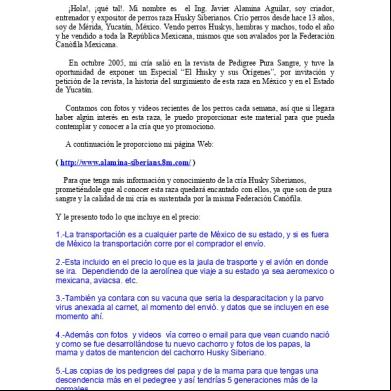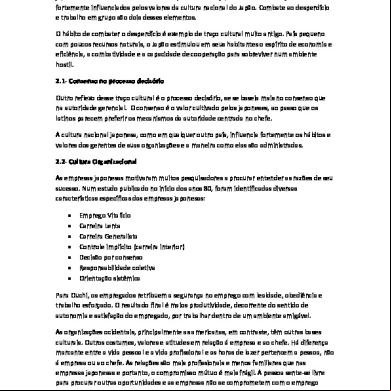Fundamentals Of Wettability 344v3f
This document was ed by and they confirmed that they have the permission to share it. If you are author or own the copyright of this book, please report to us by using this report form. Report 3b7i
Overview 3e4r5l
& View Fundamentals Of Wettability as PDF for free.
More details w3441
- Words: 563
- Pages: 19
INDEX
INTRODUCTION OBJETIVE FUNDAMENTALS OF WETTABILITY THE PRACTICAL IMPORTANCE OF WETTABILITY A PORE-LEVEL VIEW CONCLUSIONS BIBLIOGRAPHY
2
INTRODUCTION
Understanding formation optimizing oil recovery.
wettability
is
crucial
for
The oil-versus-water wetting preference influences many aspects of reservoir performance, particularly in water flooding and enhanced oil recovery techniques. Making the assumption that a reservoir is water-wet, when it is not, can lead to irreversible reservoir damage.
3
OBJETIVE
The main objective of this presentation is to understand the
basic principles of reservoir wettability, its importance, the changes that can occur and how it affects the operation of our fields.
4
FUNDAMENTALS OF WETTABILITY
Wetting forces are in play all around us. 5
FUNDAMENTALS OF WETTABILITY
Forces of wetting influence hydrocarbon reservoir behavior in many ways, including: Saturation.
Multiphase flow Certain terpretation parameters
Wettability describes the preference of a solid to be in with one fluid rather than another.
6
FUNDAMENTALS OF WETTABILITY
angle. An oil drop (green) surrounded by water (blue) on a water-wet surface (left) forms a bead. The angle θ is approximately zero. On an oil-wet surface (right), the drop spreads, resulting in a angle of about 180°. An intermediate-wet surface (center) also forms a bead, but the angle comes from a force balance. 7
FUNDAMENTALS OF WETTABILITY
8
FUNDAMENTALS OF WETTABILITY
Wettability describes the preference of a solid to be in with one fluid rather than another. A drop of a preferentially wetting fluid will displace another fluid; at the extreme it will spread over the entire surface. Conversely, if a nonwetting fluid is dropped onto a surface already covered by the wetting fluid, it will bead up, minimizing its with the solid.
9
FUNDAMENTALS OF WETTABILITY
Typically, the primary constituents of reservoirs —quartz, carbonate and dolomite— are water-wet prior to oil migration. Thus, a water-wet rock can be cleaned, dried and fully saturated with an alkane, while the surfaces in the pores remain water-wet.
10
THE PRACTICAL IMPORTANCE OF WETTABILITY
During primary recovery, productivity and oil recovery.
wettability
influences
The original wettability of a formation and altered wettability during and after hydrocarbon migration influence the profile of initial water saturation, Swi, and production characteristics in the formation.
11
THE PRACTICAL IMPORTANCE OF WETTABILITY
In a water-wet formation, the oil/water is above the
FWL, indicating that pressure must be applied to force oil into the largest pores.
12
THE PRACTICAL IMPORTANCE OF WETTABILITY
In an oil-wet formation, the is below the FWL,
signifying that pressure must be applied to force the water phase into the largest pores.
13
THE PRACTICAL IMPORTANCE OF WETTABILITY
14
THE PRACTICAL IMPORTANCE OF WETTABILITY Even in a gas reservoir, wettability or its alteration can affect recovery. Condensate blockage near a wellbore decreases gas productivity.
15
A PORE-LEVEL VIEW
Pore geometry complicates the application of the wetting principles discussed above. A angle is easiest to understand when the surface is a smooth plane.
16
CONCLUSIONS
The Wettability is a very important determining factor for:
Describe the behavior of fluids in the reservoir.
To analyze trends in hydrocarbon recovery.
In addition, you can modify this property at the convenience to order to increase the efficiency of production systems.
17
BIBLIOGRAPHY
Wael Abdallah and Jill S. Buckley. Fundamentals of Wettability. Oilfield Review Summer 2007. Volume 19, Issue 2. Schlumberger.
18
INTRODUCTION OBJETIVE FUNDAMENTALS OF WETTABILITY THE PRACTICAL IMPORTANCE OF WETTABILITY A PORE-LEVEL VIEW CONCLUSIONS BIBLIOGRAPHY
2
INTRODUCTION
Understanding formation optimizing oil recovery.
wettability
is
crucial
for
The oil-versus-water wetting preference influences many aspects of reservoir performance, particularly in water flooding and enhanced oil recovery techniques. Making the assumption that a reservoir is water-wet, when it is not, can lead to irreversible reservoir damage.
3
OBJETIVE
The main objective of this presentation is to understand the
basic principles of reservoir wettability, its importance, the changes that can occur and how it affects the operation of our fields.
4
FUNDAMENTALS OF WETTABILITY
Wetting forces are in play all around us. 5
FUNDAMENTALS OF WETTABILITY
Forces of wetting influence hydrocarbon reservoir behavior in many ways, including: Saturation.
Multiphase flow Certain terpretation parameters
Wettability describes the preference of a solid to be in with one fluid rather than another.
6
FUNDAMENTALS OF WETTABILITY
angle. An oil drop (green) surrounded by water (blue) on a water-wet surface (left) forms a bead. The angle θ is approximately zero. On an oil-wet surface (right), the drop spreads, resulting in a angle of about 180°. An intermediate-wet surface (center) also forms a bead, but the angle comes from a force balance. 7
FUNDAMENTALS OF WETTABILITY
8
FUNDAMENTALS OF WETTABILITY
Wettability describes the preference of a solid to be in with one fluid rather than another. A drop of a preferentially wetting fluid will displace another fluid; at the extreme it will spread over the entire surface. Conversely, if a nonwetting fluid is dropped onto a surface already covered by the wetting fluid, it will bead up, minimizing its with the solid.
9
FUNDAMENTALS OF WETTABILITY
Typically, the primary constituents of reservoirs —quartz, carbonate and dolomite— are water-wet prior to oil migration. Thus, a water-wet rock can be cleaned, dried and fully saturated with an alkane, while the surfaces in the pores remain water-wet.
10
THE PRACTICAL IMPORTANCE OF WETTABILITY
During primary recovery, productivity and oil recovery.
wettability
influences
The original wettability of a formation and altered wettability during and after hydrocarbon migration influence the profile of initial water saturation, Swi, and production characteristics in the formation.
11
THE PRACTICAL IMPORTANCE OF WETTABILITY
In a water-wet formation, the oil/water is above the
FWL, indicating that pressure must be applied to force oil into the largest pores.
12
THE PRACTICAL IMPORTANCE OF WETTABILITY
In an oil-wet formation, the is below the FWL,
signifying that pressure must be applied to force the water phase into the largest pores.
13
THE PRACTICAL IMPORTANCE OF WETTABILITY
14
THE PRACTICAL IMPORTANCE OF WETTABILITY Even in a gas reservoir, wettability or its alteration can affect recovery. Condensate blockage near a wellbore decreases gas productivity.
15
A PORE-LEVEL VIEW
Pore geometry complicates the application of the wetting principles discussed above. A angle is easiest to understand when the surface is a smooth plane.
16
CONCLUSIONS
The Wettability is a very important determining factor for:
Describe the behavior of fluids in the reservoir.
To analyze trends in hydrocarbon recovery.
In addition, you can modify this property at the convenience to order to increase the efficiency of production systems.
17
BIBLIOGRAPHY
Wael Abdallah and Jill S. Buckley. Fundamentals of Wettability. Oilfield Review Summer 2007. Volume 19, Issue 2. Schlumberger.
18











